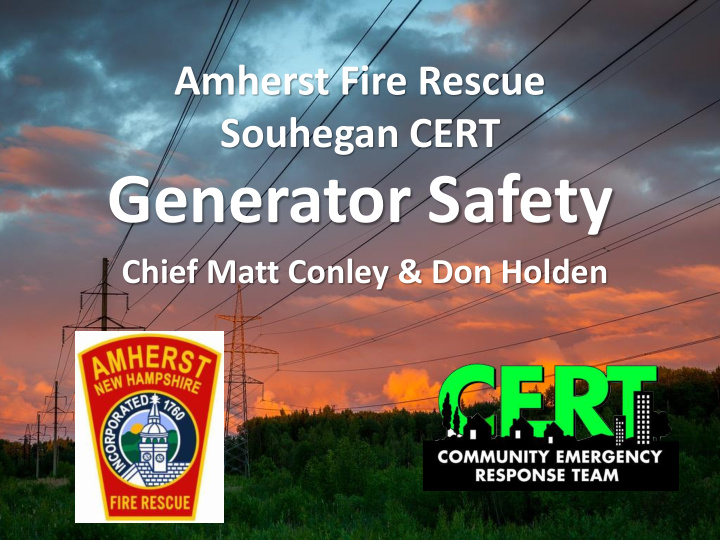



Amherst Fire Rescue Souhegan CERT Generator Safety Chief Matt Conley & Don Holden
Discussion Points • Types of generators • Generator hazards • The silent killer – CO • Safe operations
Types of Generators • Inverters or conventional generators • Inverters use digital electronics to produce smoother power for sensitive electronic devices. Quieter, more efficient, less weight. • Small inverters • 2000W – 3000W; $300 - $800 ~60 lb • Variable speeds
Types of Generators • Mid-size inverters • 3000W to 5000W $700 - $1700 • Runs 8 to 18 hours on 2 to 3 gals • Only 120v and not usable with most transfer switches
Types of Generators • Large Inverters • Up to 7500W • $3000 to $4000 • Only runs on gasoline • Special switch for connection to house
Types of Generators • Portable generators • 2000W – 8000W $500 - $2800 • Both 120 and 230 volts • Constant RPM • Uses a transfer switch to power house
Types of Generators • Permanent Generators • Up to 20kW • $2000 to $6000 plus installation (~$8000). • Propane, natural gas, diesel, or gasoline • Starts up automatically
Generator Hazards • Shocks and electrocution • Burns and fires during refueling • Noise and vibration • Carbon monoxide poisoning
Generator Hazards • Shock and electrocution • Use a transfer or interlock switch to connect a generator to house electrical system. • Use heavy duty extension cords (with GFCI recommended) if directly connecting appliances. • Ground the generator • Keep the generator dry (if possible)
Generator Hazards • Burns and fires during refueling • Generator fuels can ignite when spilled on hot engine parts. • Shut down engine and allow to cool. • Store gasoline in appropriate containers away from heat sources and flames. • Do not store fuel in living areas • Noise and vibration • Can cause hearing loss and fatigue • Wear hearing protectors for long term exposure
Generator Hazards • Carbon monoxide poisoning • Improper ventilation can cause death • Just a few minutes of exposure to high levels can cause death or permanent brain damage Concentration Symptoms 35 ppm (0.0035%) Headache and dizziness within six to eight hours of constant exposure 100 ppm (0.01%) Slight headache in two to three hours 200 ppm (0.02%) Slight headache within two to three hours; loss of judgment 400 ppm (0.04%) Frontal headache within one to two hours 800 ppm (0.08%) Dizziness, nausea, and convulsions within 45 min; insensible within 2 hours 1,600 ppm (0.16%) Headache, increased heart rate, dizziness, and nausea within 20 min; death in less than 2 hours 3,200 ppm (0.32%) Headache, dizziness and nausea in five to ten minutes. Death within 30 minutes. 6,400 ppm (0.64%) Headache and dizziness in one to two minutes. Convulsions, respiratory arrest, and death in less than 20 minutes. 12,800 ppm (1.28%) Unconsciousness after 2 – 3 breaths . Death in less than three minutes .
Avoiding Carbon Monoxide • Never use a generator indoors, in a basement or garage or any enclosed area without adequate ventilation. Open windows and doors are not enough. • Have 3 to 4 ft clear space all around and above portable generator. • 5 ft for permanent generators, 10 ft for portable. • Do not place outdoors near open windows or vents.
Avoiding Carbon Monoxide • Battery operated CO detectors • Digital detectors can show levels of CO. • $25 to $75
Questions?
Recommend
More recommend